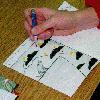| Literature Circles Resource Center | |
| home | site map | structure | books | discussion | written response | themed units | extension projects | |
 |
|
Literature
Circles Structure: 5th Grade Kirstin Gerhold Columbia Elementary School Mukilteo, Washington |
Choosing books At the start of the year I have the whole class read one book so we can focus on learning how to discuss and respond to literature. By the end of the year I offer students a choice, and the class reads 5 or 6 books at a time. It is important to use books that will engage the studentsí interests. I also find that it is helpful to use books related to a theme so we can hold whole class discussions. I usually choose a theme that relates to another unit in the curriculum so we can build connections between subject areas. Introducing books At the start of each round of literature circles I give book talks on ~10 books. The number of books varies depending on the number of books I find that relate to our theme and whether or not I can find multiple copies of each book. After the book talks I give students a chance to look at the books then they vote for their top 3 choices. From their votes (and my common sense) I place students into groups of 4-6 students per book. The groupsí first task is to create a reading schedule. I tell them when the book needs to be finished and which days they will be discussing. The reading schedule tells the students how much they need to read for each discussion day. I give the students a calendar with the discussion days labeled, and they use this to record their reading schedule. Weekly schedule I teach in a district that recently adopted a new reading curriculum that includes an integrated reading anthology, language arts curriculum and spelling curriculum. Since there is a strong emphasis on this curriculum, I alternate between working in the anthology and doing literature circles. For example, we might work in the anthology on Tuesday and Thursday and do literature circles on Monday, Wednesday and Friday. With some rounds of literature circles, I use books that relate to the theme of our reading unit so we can integrate the two. Each round of literature circles lasts approximately 6-8 weeks from starting the books to finishing the final projects. Daily schedule Each literature circle day has a similar structure. Before class the students read their book and mark sections they want to share with Post-it Notes. We start our literature circle time with a focus lesson. The focus lesson may include a variety of topics. During the first few rounds of literature circles these focus lessons are when I teach students how to participate in a discussion. Later, these lessons are where I integrate other reading and language arts lessons, such as figurative language, characterization, sequencing. These focus lessons are either integrated into their discussions or into their journal writing. After the focus lesson, students break into their groups and discuss. Students share parts of their book that they found interesting, they ask open-ended questions, talk about what they like and donít like, relate parts of the story to their lives, predict, and share their journal entries. On some discussion days I also give students a specific topic or question to include in their discussion. After discussing, students write in their journals in response to a journal prompt or in answer to a question. They may also respond to something that was brought up in their group discussion. It is important to give students some choice in what they are writing about in their journals. The end of each session is the most important. We debrief as a class: What went well in your discussions? What can you do better next time? I give examples of things that I noticed while I was monitoring the groups. During this process we refer to the criteria we established early in the year for what makes a good discussion. It is very important to have the students reflect and set goals for the future because this is where I see the most progress in their discussion abilities. Final project We end each round of literature circles
with a final response project. The type of project students create
varies with each round. I offer students a choice of projects, and
I show them examples when available. We create evaluation criteria
as a class so they know the expectations up front. For each project,
students create a rough draft that I check off before they start
the final copy. At the end of the project the students evaluate
their own project based on the criteria we created. Book Sets for Literature Circles Whole Class Book (first literature circle round): Waterman's Boy by Susan Sharpe (NY: Bradbury Press, 1990). Theme: Facing Hard Times with Courage (Revolutionary War focus): My Brother
Sam is Dead by James Lincoln Collier & Christopher Collier
(NY: Simon & Schuster, 1974). Theme: Growth and Change The Great Gilly
Hopkins by Katherine Paterson (NY: Thomas Y. Crowell, 1978)
|
home
| site map | structure
| books | discussion
| written response
| themed
units | extension projects
|
Literature
Circles Resource Center © 2002 Katherine L. Schlick Noe School of Education Seattle University 900 Broadway Seattle, WA 98122 kschlnoe@seattleu.edu |